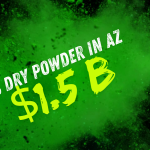Where is the Dry Powder in Arizona
In 2024, while many U.S. startup ecosystems were struggling, Arizona did something unexpected: it held the line. The state didn’t boom, but it didn’t break either. Instead, Arizona showed a kind of stubborn strength like a scrappy desert fighter refusing to go down even when the national market tightened its grip.
Yes, the numbers did dip a little. Startups raised $1.2 billion across 129 deals, compared to $1.3 billion across 134 deals in 2023. But if you think that’s a bad sign, look again. In a year when many regions saw venture capital investments halve, Arizona’s modest decline appears more like a badge of durability than a weakness.
This wasn’t a collapse. It was a controlled reset and one that puts Arizona in a perfect position for a serious rebound in 2025. It should be noted that the term used by VCs that you don’t typically hear is “dry powder.” In venture capital, “dry powder” is the uninvested capital a firm has committed to raising but has not yet deployed. This number is estimated to be around $1.5 billion for Arizona VCs.
The Dry Powder Problem and Why Arizona Is Still Undervalued
Here’s the part no one likes to talk about: Arizona is overflowing with dry powder, yet most of it sits on the sidelines. Across the U.S., venture funds, corporate investors, family offices, and private capital pools are holding record amounts of undeployed cash. Billions are waiting to be put to work. But in Arizona, too much of that capital is gathering dust because local investors want “less risk, more proof, more traction, more everything.”
Meanwhile, founders in Houston, Raleigh, Boulder, and Salt Lake City are securing funding from the same national firms that have been overlooking Arizona startups.
Dry powder isn’t the problem. Deployment is.
The opportunity is obvious:
Invest early in the frontier-tech companies. Arizona is uniquely positioned to produce optics, photonics, aerospace, manufacturing tech, solar, robotics, and AI. If Arizona doesn’t seize this moment, outside investors will. And they’ll reap the returns Arizona should have claimed.
How? By relocating our rockstar startups to their playgrounds.
The problem is also apparent:
We’re not equipping our innovators to build credible plans, powerful stories, or investor-ready pitches. And too many of our leaders are focused on the wrong things, missing the chance to show venture capital firms the goldmine sitting right in front of us.
Startup Zones is squarely focused on addressing this problem.
Arizona’s Strengths Became Impossible to Ignore
The 2024 funding data highlights something Arizona leaders have known for years: the state’s real power comes from frontier-tech, not imitation Silicon Valley clones.
The hottest sectors included:
- Optics and Photonics (enabling technology for everything)
- AI
- Quantum
- Robotics & automation
- Advanced manufacturing
- Space & aerospace systems
- Biotech and medical devices
These sectors align perfectly with Arizona’s universities, defense contractors, aerospace supply chains, and, most importantly, their engineering talent. The state is finally leaning into what it does best instead of trying to be another “Silicon Something.”
A National Slowdown… But Arizona Bent, Didn’t Break
Across the U.S., VC slowed down. Investors hunted for profitability. Significant funds tightened their wallets. IPOs dried up. Many early-stage founders discovered that the money “always being there” was a myth.
But Arizona? It absorbed the impact. And by the end of the year, analysts were calling it “a market showing early signs of recovery going into 2025.”
That means:
- More out-of-state investors are circling.
- Deal sizes are stabilizing.
- Frontier-tech is finally getting respect.
- Arizona is gaining its own gravitational pull.
- Workforce is getting attention
This is precisely how ecosystems evolve from “emerging” to “real.”
Why 2025 Could Be the Turning Point
All signs point to this year being the reset before a surge. Arizona now has:
- A stronger engineering pipeline
- Lower operating costs than coastal hubs
- A rapidly growing supply of manufacturing and robotics talent
- A rising reputation in aerospace, photonics, and frontier tech
- More out-of-state investors are watching closely
Arizona is entering a moment where “steady” becomes “strategic advantage.”
While other ecosystems are trying to rebuild their momentum, Arizona never lost it. It simply shifted into a different gear, a more disciplined, more technical, more durable one.
The Bottom Line: Arizona Didn’t Shrink, It Hardened
2024 wasn’t a blockbuster year, but it was the year Arizona proved it wasn’t fragile. The state didn’t chase hype. It leaned into its strengths. It nurtured frontier-tech. It doubled down on deep engineering. And now it’s stepping into 2025 with more stability, more opportunity, and more attention than ever.
Arizona isn’t trying to be Silicon Valley.
It’s showcasing Optics Valley:
A frontier-tech powerhouse in optics, photonics, space, solar, robotics, advanced manufacturing, MedTech, Biotech, quantum, and cybersecurity built by engineers who don’t flinch and founders who don’t quit.








